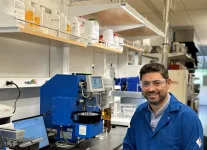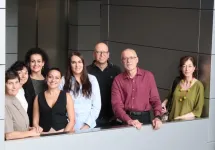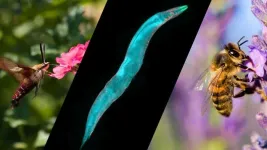(Press-News.org) Targeting failure with new polymer technology to enhance sustainability
Sustainability is a complex problem with many different players and influenced by policies, society, and technical perspective.
We are reminded every day in the media of the unnecessary amount of waste that we are generating with pervasive pictures of plastic garbage patches floating in the oceans or stranded on our beaches.
Scientists within ASU’s School of Molecular Sciences (SMS) and the Biodesign Institute’s Center for Sustainable Macromolecular Materials and Manufacturing (SM3) are pursuing a multi-pronged approach towards a more circular economy, with projects focused on biosourcing, recycling, water purification, or carbon capture to name a few.
One obvious strategy to limit the vast amount of materials wasted is to reduce the need to produce plastics worldwide. “That is easier said than done!” says associate professor Yoan Simon of ASU’s SMS and SM3. “However, the antidote could simply be to prolong the lifespan of parts.”
From tethers in backpacks to container lids, we are surrounded by parts that must withstand thousands of opening and closing cycles. Likewise, bike and football helmets must withstand repeated impacts and maintain a given level of protection without failing.
As the saying goes, “If it ain’t broke, don’t fix it! But how exactly does it break?” asks Simon. “What happens when you throw a projectile at a material supposed to absorb shocks repeatedly?”
A collaborative team co-led by the Simon research group at ASU in collaboration with the National Institute of Standards and Technology (NIST), the University of Southern Mississippi, Rensselaer Polytechnic Institute, and the Army Corps of Engineers have developed a new material that provides new information about how materials respond to impact at high velocity.
The study, just published in Nature Communications, demonstrates how a polymer containing mechanophores -molecules that illuminate under large mechanical force- can visually record the response of the material to high-speed projectile impacts. Notably, the mechanophores captured subsurface distortions in the material, information that was previously impossible to access. By integrating molecular-level interactions with advanced imaging techniques, the scientists can now visualize the formation of Mach cones-acoustic waves that travel faster than the speed of sound in the material.
Simply speaking, they have introduced molecular reporters that light up like a Christmas tree (or in this case a Mach cone) when the speed of the projectile exceeds the speed of sound in the material, similar to the boom that occurs when a jet fighter goes supersonic.
Simon, whose group has spent decades working on introducing luminescent or color-changing probes in materials to understand how materials respond to mechanical events, is buoyant about this collaborative piece of work. “For years, many groups have shown activation in materials whose deformation was visible to the naked eye, limiting the applicability of these molecular probes,” explains Simon. “What’s really novel about this study is that it provides us with a unique tool to look at what happens deep inside the material. We get to see how waves propagate in the material upon impact.”
This work combined some heavy computational efforts with advanced analytical methods developed at NIST to evaluate the aftermaths of impact.
“In simple terms, we used a microscopic gun to shoot microprojectiles at materials and use ultrafast cameras and advanced microscopy to get some critical information about the energy absorbed and how it is transmitted through the material,” says Simon. Beyond this work, these probes could provide deeper insights into various impulsive events, including mild traumatic brain injuries, cold spray additive manufacturing, or hypervelocity impacts in space.
“Edwin Chan and his team (NIST) have been instrumental in getting this project together,” explains Simon. “He and I were classmates in grad school at the University of Massachusetts, Amherst, many moons ago and that friendship has enabled this project to see the light of day.”
END
Targeting failure with new polymer technology to enhance sustainability
2024-10-07
ELSE PRESS RELEASES FROM THIS DATE:
Stigma has a profound impact on health outcomes must be addressed
2024-10-07
A new article published in Nature Reviews Disease Primers underscores the profound role that stigma can play in health care -- and how addressing stigma-related barriers can significantly improve health outcomes for individuals and communities around the world.
“Stigma has harmful effects on health, equity and justice,” says lead author Carmen Logie, a professor at the University of Toronto’s Factor-Inwentash Faculty of Social Work (FIFSW). "And while we need more rigorous evaluation of interventions ...
Has the affordable care act’s dependent coverage expansion benefited young adults diagnosed with cancer?
2024-10-07
The federal Patient Protection and Affordable Care Act (ACA) passed in 2010 includes a Dependent Coverage Expansion (DCE) provision that permits dependents to remain on their parents’ health insurance plans from age 19 to 25 years, the age group that has historically had the highest uninsured rate in the United States. A recent analysis reveals that during the ACA’s first decade, survival rates of DCE-eligible young adults with cancer have improved. The findings are published by Wiley online in CANCER, a peer-reviewed journal of the American Cancer Society.
To examine whether young adults with cancer diagnoses have ...
A new study reveals a key mechanism driving atherosclerosis in Hutchinson-Gilford Progeria Syndrome
2024-10-07
A team of researchers from the Centro Nacional de Investigaciones Cardiovasculares Carlos III (CNIC), the Centro de Investigaciones Biológicas Margarita Salas (CIB-CSIC), and the Instituto de Ciencias de Materiales de Madrid (ICMM-CSIC) has made a significant breakthrough in understanding the underlying causes of cardiovascular disease in patients with Hutchinson-Gilford progeria syndrome (HGPS), an ultra-rare genetic disorder that accelerates the aging process. The most serious consequence of HGPS is the early onset of cardiovascular disease, leading to premature death at an average age of 14.5 years.
The study was led by Dr. Vicente Andrés, ...
HPV vaccination switch to 1-dose gender-neutral approach
2024-10-07
Canadian vaccination programs could switch to a 1-dose gender-neutral human papillomavirus (HPV) vaccination approach and eliminate cervical cancer, suggests new modelling in CMAJ (Canadian Medical Association Journal) https://www.cmaj.ca/lookup/doi/10.1503/cmaj.240787.
“Our results have important policy implications in Canada, and in other similar high-income countries evaluating whether to switch to 1-dose HPV vaccination,” writes Dr. Marc Brisson, a full professor at Laval University, Québec, and director of the Mathematical Modeling and Health Economics of Infectious Diseases Lab at the ...
Scurvy: Not just an 18th-century sailors’ disease
2024-10-07
Scurvy, or vitamin C deficiency, is not just an 18th-century seafarers’ disease, as a case study of a 65-year-old woman with mobility issues and social isolation shows. In an article published in CMAJ (Canadian Medical Association Journal) https://www.cmaj.ca/lookup/doi/10.1503/cmaj.240769, clinicians describe how scurvy should be considered in patients with abnormal bleeding and nonspecific symptoms.
The patient visited the emergency department at a downtown Toronto hospital for leg pain and weakness, skin lesions, and discoloration. She also had several chronic health ...
Scientists discover a secret to regulating our body clock, offering new approach to end jet lag
2024-10-07
Singapore, 7 October 2024—Scientists from Duke-NUS Medical School and the University of California, Santa Cruz, have discovered the secret to regulating our internal clock. They identified that this regulator sits right at the tail end of Casein Kinase 1 delta (CK1δ), a protein which acts as a pace setter for our internal biological clock or the natural 24-hour cycles that control sleep-wake patterns and other daily functions, known as circadian rhythm.
Published in the journal PNAS, their findings could ...
Impact of pollutants on pollinators, and how neural circuits adapt to temperature changes
2024-10-04
The Kavli Foundation and the U.S. National Science Foundation are collaborating to accelerate research in the emerging field of neurobiology in changing ecosystems, stemming from the foundation’s efforts in this area first announced in 2023. A joint Kavli-NSF grantmaking program was launched in December of 2023.
Building on early success of this program, Kavli and NSF announce its continuation with a second call for proposals, open through February 10, 2025, for projects tackling hard problems in this understudied field.
Research ...
Researchers seek to improve advanced pain management using AI for drug discovery
2024-10-04
An estimated one in five Americans live with chronic pain and current treatment options leave much to be desired. Feixiong Cheng, PhD, Director of Cleveland Clinic’s Genome Center, and IBM are using artificial intelligence (AI) for drug discovery in advanced pain management. The team’s deep-learning framework identified multiple gut microbiome-derived metabolites and FDA-approved drugs that can be repurposed to select non-addictive, non-opioid options to treat chronic pain.
The findings, published in Cell Press, represent one of many ways the organizations' Discovery Accelerator partnership is helping ...
‘Neutron Nexus’ brings universities, ORNL together to advance science
2024-10-04
Oak Ridge National Laboratory has launched its Neutron Nexus pilot program with Florida Agricultural & Mechanical University, or FAMU, and Florida State University, or FSU, through the FAMU-FSU College of Engineering. The first program of its kind nationwide, it’s aimed at broadening and diversifying the scientific user community with outreach to universities and colleges to increase collaboration and, ultimately, scientific advancement.
Although a recently planned two-day “ORNL Days” event in Florida was cut ...
Early release from NEJM Evidence
2024-10-04
This article was published Early Release to coincide with a presentation at the Symposium on Advanced Wound Care in Las Vegas, NV.
Full text is now available on evidence.nejm.org. Email mediarelations@nejm.org for access.
Original Article: Intact Fish Skin Graft to Treat Deep Diabetic Foot Ulcers
Dured Dardari, M.D, Ph.D., From the Diabetology Department, Center Hopitalier Sud Francilien, Corbeil-Essonnes, France, and the LBEPS, Université d’Evry, IRBA, Université Paris Saclay, 91025 Evry, France.
If you have any questions for our office, please contact our Media Relations ...




